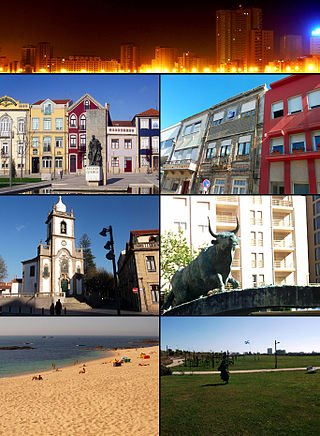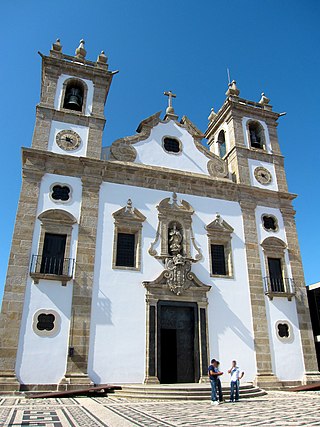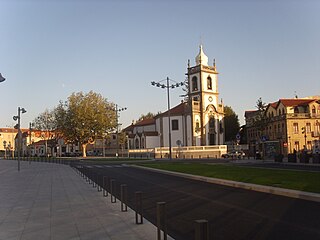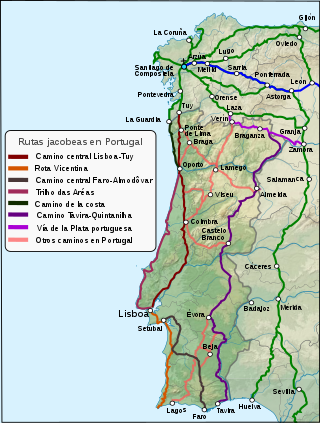
Sancho I of Portugal, nicknamed "the Populator", King of Portugal was the second but only surviving legitimate son and fifth child of Afonso I of Portugal by his wife, Maud of Savoy. Sancho succeeded his father and was crowned in Coimbra when he was 31 years old on 9 December 1185. He used the title King of Silves from 1189 until he lost the territory to Almohad control in 1191.

Póvoa de Varzim is a Portuguese city in Northern Portugal and sub-region of Greater Porto, 30 km (18.6 mi) from its city centre. It sits in a sandy coastal plain, a cuspate foreland, halfway between the Minho and Douro rivers. In 2001, there were 63,470 inhabitants, with 42,396 living in the city proper. The city expanded southwards, to Vila do Conde, and there are about 100,000 inhabitants in the urban area alone. It is the seventh-largest urban agglomeration in Portugal and the third largest in Northern Portugal.

Vila do Conde is a municipality in the Norte Region of Portugal. The population in 2011 was 79,533, in an area of 149.03 km2. The urbanized area of Vila do Conde, which includes the parishes of Vila do Conde, Azurara and Árvore, represent 36,137 inhabitants. Vila do Conde is interlinked to the north with Póvoa de Varzim, forming a single urban agglomeration which is a part of the Porto Metropolitan Area. The town is on the Portuguese Way of the Camino de Santiago.

Beatrice of Castile or Beatriz was an infanta of Castile, daughter of Sancho IV and María de Molina. She was Queen of Portugal from the accession of her husband, Afonso IV, in 1325 until his death on 28 May 1357.

Terroso is a suburban area in Póvoa de Varzim, Portugal. It forms part of the civil parish of Aver-o-Mar, Amorim e Terroso. It is an ancient ecclesiastical parish and former civil parish. In the census of 2001, it had a population of 2,472 inhabitants and a total area of 4.63 km2. A 2012 law merged the civil parish with neighbouring Amorim and Aver-o-Mar, to become the northern parish of the city of Póvoa de Varzim.

The Aqueduct of Santa Clara is the second largest Portuguese aqueduct system. Built between 1626 and 1714, it includes 999 arches stretching for 4 kilometres (2.5 mi) from the spring of Terroso in the municipality of Póvoa de Varzim to the Convent of Santa Clara in the municipality of Vila do Conde.

Praça Velha, formerly known as Praça (Square), was the primitive civic center and the market square of the city of Póvoa de Varzim in Portugal. It is located in Bairro da Matriz historic district and is surrounded by the main church of Póvoa de Varzim, the primitive Town Hall and the house of a notable 17th-century Póvoa de Varzim seafarer.

Largo das Dores or Dores Square is a square in Póvoa de Varzim city center in Portugal. Part of the earliest old town of Póvoa de Varzim, this area is listed by City Hall as heritage site. With about 11.000 square meters, its most noticeable features are its two churches, located in the sites of ancient chapels, one of which was the main church of the city.

The history of Póvoa de Varzim, Portugal, and its development as a maritime trade and fishing hub, have been greatly influenced by its location at the entrance to one of Portugal's best natural ports.

The architecture of Póvoa de Varzim, in Portugal, demonstrates a broad variety of architectural styles over its thousand years of history. 11th-century Romanesque, 16th-century Mannerism, 18th-century Baroque, late 18th-century neoclassicism, early 20th-century Portuguese modernism and late 20th- to early 21st-century contemporary architectural styles and more are all represented in Póvoa de Varzim. As a whole it represents a rich eclectic tradition and innovation shaped by the people, their beliefs and economy.
João Afonso de Albuquerque,, Juan Alfonso de Alburquerque in Spanish and nicknamed "o do Ataúde", 6th Lord of Alburquerque, was a member of the highest ranks of the nobility of the Kingdom of Portugal, an astute politician, and descendant from the royal houses of both Portugal and Castile, although through illegitimate lines.
Gil Vázquez de Soverosa was a member of the nobility of the Kingdom of Portugal, of the Soverosa lineage which had its origins in Galicia. He appears frequently as a member of the curia regis confirming royal charters of Kings Sancho I, Afonso II, and Afonso III of Portugal.

Afonso Sanches, Lord of Albuquerque, also known as Alfonso Sanches, was a Portuguese nobleman, Lord of Cerva and Alburquerque.

João Afonso Telo de Menezes was a Portuguese nobleman, 1st Count of Ourém and 4th Count of Barcelos.

Lopo Fernandes Pacheco, was the first of his lineage to accede to the highest ranks of the nobility, that of a rico-homem, in the Kingdom of Portugal. He lived during the reign of King Afonso IV of Portugal of whom he was his favorite and loyal vassal. His parents were João Fernandes Pacheco and his wife Estevaínha Lopes de Paiva, daughter of Lope Rodrigues de Paiva and Teresa Martins Xira. His family owned properties in different parts of the kingdom although its area of influence was mainly Beira in the northern part of the country.

João Afonso Telo, was the 4th Lord of Albuquerque and the 1st Count of Barcelos.

The Portuguese Way is the name of the Camino de Santiago pilgrimage routes starting in Portugal. It begins at Porto or Lisbon. From Porto, along the Douro River, pilgrims travel north crossing the five main rivers—the Ave, Cávado, Neiva, Lima and Minho—before entering Spain and passing through Pontevedra on the way to Santiago de Compostela.


















